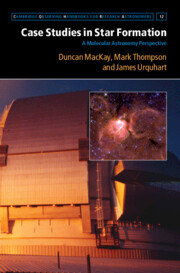Book contents
- Frontmatter
- Dedication
- Contents
- Preface
- List of Acronyms
- Part I Introduction
- Part II Low-Mass Star Formation (LMSF)
- Part III High-Mass Star Formation (HMSF)
- 6 Two HMSFR Surveys Using APEX and NOEMA
- 7 Sagittarius B2
- 8 G29.96 ˗0.02 in W43
- 9 Orion BN/KL
- Part IV Ionisation
- Part V Photodissociation
- Part VI External Galaxies
- Appendices
- List of Research Journal Abbreviations
- References
- Chemical Index
- Subject Index
6 - Two HMSFR Surveys Using APEX and NOEMA
from Part III - High-Mass Star Formation (HMSF)
Published online by Cambridge University Press: 11 April 2023
- Frontmatter
- Dedication
- Contents
- Preface
- List of Acronyms
- Part I Introduction
- Part II Low-Mass Star Formation (LMSF)
- Part III High-Mass Star Formation (HMSF)
- 6 Two HMSFR Surveys Using APEX and NOEMA
- 7 Sagittarius B2
- 8 G29.96 ˗0.02 in W43
- 9 Orion BN/KL
- Part IV Ionisation
- Part V Photodissociation
- Part VI External Galaxies
- Appendices
- List of Research Journal Abbreviations
- References
- Chemical Index
- Subject Index
Summary
Two surveys of high-mass star formation (HMSF) are discussed. One is the APEX Telescope Large Area Survey of the Galaxy (ATLASGAL), using the Atacama Pathfinder Experiment (APEX) 12 metre dish. The other uses the Institut de Radioastronomie Millimetrique (IRAM) Northern Extended Millimetre Array (NOEMA). The value of a representative survey of HMSFRs lies in learning what physical and chemical parameters are shared across a variety of sources. The results of statistically large samples of detected, or non-detected, sources such as that of ATLASGAL provide secure data from which to generalise about the typical star-formation process. The results of smaller but still multi-location studies such as the NOEMA sample give us greater specific details, albeit from a self-selecting sample, which may or may not be typical but that we can certainly say are common, at least until future wider surveys demonstrate error.
- Type
- Chapter
- Information
- Case Studies in Star FormationA Molecular Astronomy Perspective, pp. 107 - 123Publisher: Cambridge University PressPrint publication year: 2023

